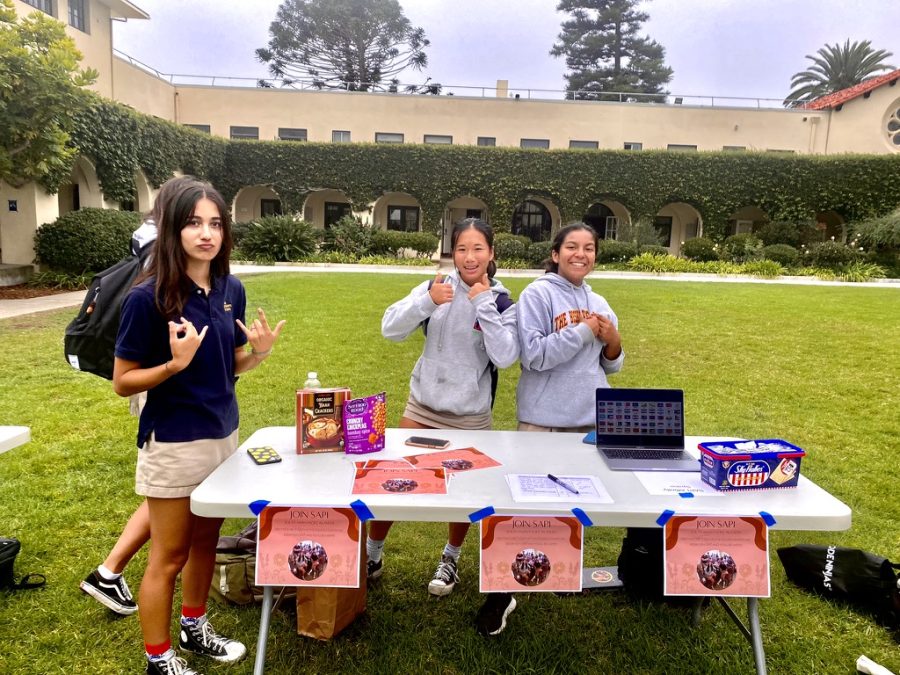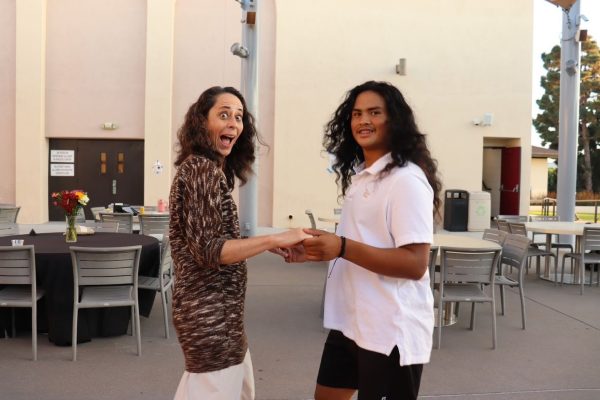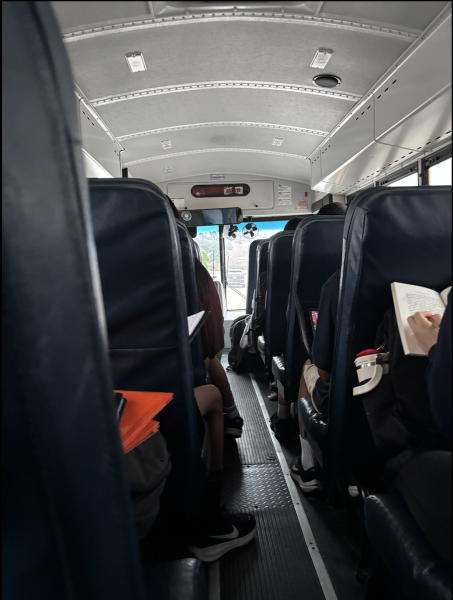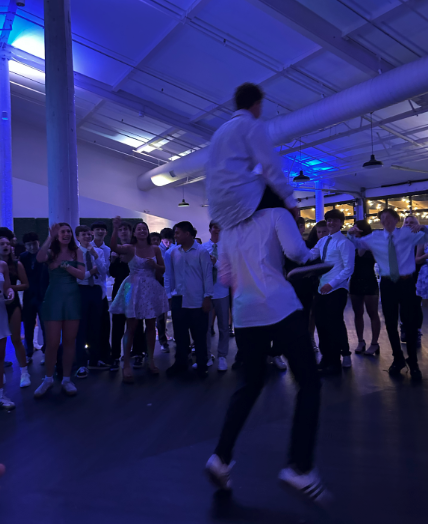A Guide to Affinity Groups
Building Community through Culture
South Asian and Pacific Islanders (SAPI) leaders Nirvana Shiwmangal (‘25) and Safina Abraham (‘25) and member Gabby Gaspar (‘25) share their culture’s snacks at their booth during the club fair on September 29th.
An Introduction to Affinity Groups:
The rustle of snacks, the relaxed chatter from the DEIJ room, and the color of culture. The inviting atmosphere and low-stakes community building are some of the ways affinity groups appeal to students of all races.
Affinity groups are a fundamental part of the Diversity, Equity, Inclusion, and Justice (DEIJ) program at Bishop’s. According to the Bishop’s website, “affinity spaces cultivate a sense of belonging for people of a shared identity.” It says they are open to all and are centers of “discussion and cultural celebration.” Additionally, it states that “diversity collectives are spaces where people of various intersectional identities and interests come together to work toward a common goal.”
East Asian Student Association (EASA) Co-leader Audrey Lin (‘25) emphasized the benefits of joining an affinity group. “I think joining an affinity group is a really awesome opportunity to talk with others who may have shared experiences, and bond over your culture and traditions,” she said.
Some affinity spaces tend to be closed, while others are more open to other people joining in on discussions. The difference between the two types lies in the purpose of the affinity space. EASA member Selene Wang (‘25) agreed with this statement, saying, “there are some groups that are more comfortable as a community. These groups have less of a need for a closed affinity space because there isn’t a fear that if someone else enters it will make the space uncomfortable.”
Affinity groups are also a way to address the every-day issues students face in their relationship with their race. South Asian and Pacific Islanders (SAPI) Co-Leader Nirvana Shiwmangal said that a lot of “topics we talk about shouldn’t be closed topics.” Nirvana elaborated on this thought. “We want other people to realize…the stereotypes in the media… and this is why it is hurtful,” she said.
Keeping in mind the purpose of affinity groups, here is an organized guide of all of the affinity groups offered at Bishop’s and some events to look forward to from them:
BARC (Bishop’s Anti-Racist Collective)
“Unlike the other affinity groups, [BARC] is not for a specific group of people. It is not minority based,” Kosi said, “literally everyone is welcome.” BARC is an open affinity space that works to understand and combat racism and prejudice by providing a platform for discussion. According to the Bishop’s website, BARC welcomes all perspectives and opinions in their mission to achieve this. In BARC, conversations can cover a variety of topics. An example of a recent discussion they had was about how race is depicted in Hollywood, prompted by the recent reveal of Halle Bailey, a black singer, as Ariel in the new live-action adaptation The Little Mermaid. They meet on C days in the DEIJ room for anyone interested in diving beyond the DEIJ discussions during enrichment or listening to a variety of perspectives.
BAQN (Bishop’s Alliance of Queers and Nonqueers)
BAQN Co-leader James Stutts (‘23) says that “those who are not queer are welcome at BAQN, but the space is primarily focused on queer voices.” He added, “the space is not so much focused on education, rather we want to uplift and provide a safe space for queer students on campus.” In order to educate others around campus and provide an educational platform, BAQN is planning on providing fun events and opportunities. October 11th was National Coming Out Day, and so BAQN members brought awareness to the day by offering free-dress, hanging pride flags around campus, and more. BAQN meets on E days. Reach out to James or any of the other BAQN leaders (Eliana Birnbaum-Nahl (‘23), Theo Cleary (‘24), and Jack Rudy (‘26)) for more information.
BSU (Black Student Union)
BSU is starting to be a more open affinity space. It serves as a safe-space for black students and people of color (POC). Co-leader of BSU Raynall Thornton (‘23) said that in BSU “we can literally talk about anything we want…it’s a very open space where we can talk about anything whether it’s serious or not.” Member of BSU Malaya Taylor (‘25) said, “I would describe BSU as a community where we can come together and speak our minds.” BSU members got the opportunity to watch Black Panther: Wakanda Forever when it was released, allowing for the group to bond. BSU meets during lunch and X-periods every A day in the DEIJ room.
EASA (East Asia Student Association)
EASA is one of the busiest and most bustling open affinity groups on campus — with a large demographic of East Asian students on campus, it is no surprise that their meetings are often filled with many students, laughter, and Asian candies. EASA focuses on the celebration of culture both within the affinity space and outside. “We try and educate each other about our cultures because EASA means so many countries, so many specific cultures,” Kosi said. He said that the space builds a community by being more “cultural-learning based,” catering towards the education of East Asian cultures. Students should look forward to EASA’s annual Lunar New Year celebration that occurs in January. EASA meets on D-days in the DEIJ room.
JSA (Jewish Student Association)
According to the Bishop’s website, the Jewish Student Association (JSA) is an open affinity group aimed at providing the “opportunity for students (both Jewish and non-Jewish) to come together and talk about Jewish culture.” JSA meets on F days in the DEIJ room. JSA leader Lily Gover (‘24) says that JSA and all affinity groups, in general, were spaces where people can “feel like they belong,” emphasizing the inclusivity aspect of DEIJ. In September, JSA celebrated Yom Kippur and Rosh Hashanah by laying out apples, honey, and challah bread during milk break to symbolize a sweet new year. JSA is a place where students can come together to talk about lighter issues like holidays and culture or other more serious discussions like anti-semitism and stereotypes. Lily says that a goal she has for JSA this year is to “associate more positive things and celebrations with Judaism” and to show the beauty behind the religion.
LASO (Latinx American Student Association)
LASO is an open affinity group that is aimed at uniting the Latinx student body at Bishop’s, while also being a place to educate others. LASO Co-leader Athena Hernandez (‘23) said, “Even if you don’t identify with being Latinx-American, you can still appreciate and learn about our heritage in a comfortable space.” Athena feels there is a large spectrum when it comes to how connected Latinx-American students feel to their culture. “Growing up in the U.S. for some kids largely affects how in touch they stay with their culture,” she said, “LASO helps students feel more comfortable at Bishop’s and stay connected with our culture which at times proves difficult within the United States and specifically La Jolla.”
With a dance floor, color-dressed tables, and a tasty snack bar filled with Hispanic snacks, LASO held a Salsa & Bachata Baile in celebration of Hispanic Heritage month in September. They also had a piñata celebration during middle school lunch. Students and LASO members should look forward to a possible posada (celebration of the Christmas story) in December and participation in the San Diego Latino Film Festival. LASO meets on B days in the DEIJ room.
MSA (Muslim Student Association)
MSA is starting to transition to be a more closed affinity space. Although Bishop’s has a smaller population of Muslim students, MSA leader Zayd Aslam (‘23) and Co-Leader Kenan Begovic (‘24) are working to promote a safe space for Muslim students. The Bishop’s website states that MSA aims to “foster dialogue to help address misconceptions about Islamic faith and related controversial topics.” Kenan and other members of MSA hope to emphasize more celebrations of the Islamic faith, especially Ramadan. MSA plans to hold an Eid dinner in April. MSA meets on E days in the conference room.
MSG (Multi-racial Student Group)
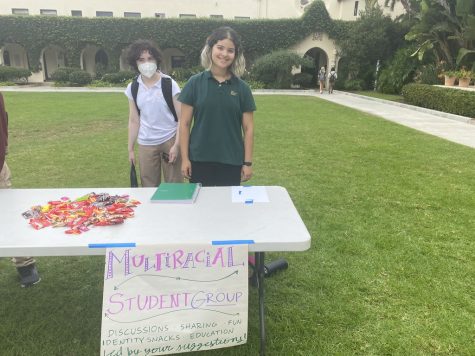
(Summer Hu)
A fairly newer affinity group, MSG provides a way for students of mixed descent to discuss with others who share the same experiences. A Multi-racial Student Group (MSG) leader, as well as a leader for West Asian and North African Student Association (WANASA) Ariston Oakes (‘23) believes that MSG’s purpose is unique from other affinity spaces. “I think for MSG it’s definitely a little bit different…[it] is more about dealing with the struggles that come with being a part of two identities and just sort of how to embrace that,” he said. MSG meets every other F day during lunch in the DEIJ room.
SAPI (South Asian Pacific Islander)
“Join SAPI to be happy,” joked Nirvana when asked why people should join SAPI. “We are open to all people of all demographics joining because [SAPI] it’s there to educate people and to make people feel like they can have these kinds of conversations about their identity,” Nirvana continued. For example, in a recent meeting, they discussed stereotypes South Asian and Pacific Islanders face. Although it seemed like a serious topic, the group bonded and laughed about the different stereotypes. SAPI, in collaboration with parent volunteers, held its annual Diwali celebration on October 21st. Parents served samosas and mango lassi while traditional music boomed over the loudspeaker. Dancing and a henna booth were both available for students to participate in. However, Nirvana hopes that people can see their culture beyond just the holidays that are celebrated at Bishop’s. SAPI currently meets on F days* in the conference room during lunch!
* note that this may be subject to change, as they are currently working on changing the letter day.
WANASA (West Asian and North African Student Association)
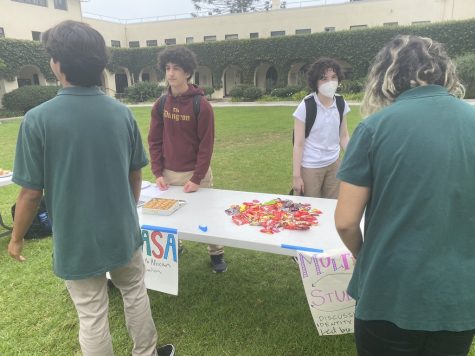
WANASA, formerly known as the Middle Eastern Student Association (MESA), meets during G day lunch in the DEIJ room. WANASA is a generally open affinity group. However, when people who are of this affinity share personal experiences with their identity, meetings tend to be closed. An interesting new change to WANASA was, as you may have noticed, the name change. Student leaders of WANASA all agreed this year to change the name. Ariston and fellow leader Emma Mandany (‘24) agreed that, historically, it’s developed a negative connotation. In his Daily Urinal article, “West Asian Hate,” Ariston elaborated on this dilemma. “One of the most widely accepted and prevalent forms of discrimination against West Asians is the continued usage of the term ‘Middle Eastern,’” he said. Emma likes being a part of WANASA because not only is she proud of her culture, but it allows her to “grow that culture and share it with other people.” Their current goal is to share and educate others on West Asian and North African culture.
Affinity groups are a great way for people to get involved with the Bishop’s community and meet new people, as well as foster a more diverse and inclusive school.
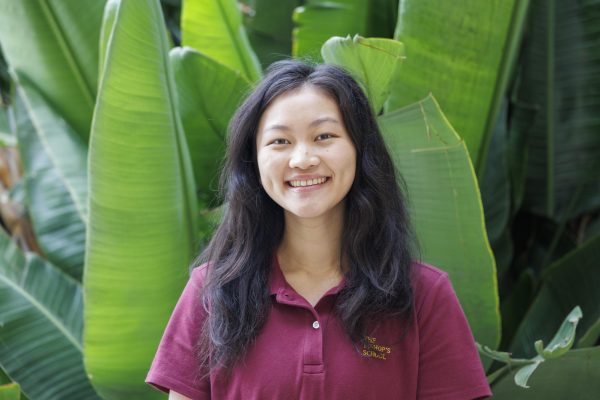
Summer is a senior and Editor-in-Chief of The Tower. This is her fourth year on the staff and third on the editorial team, previously serving as a story...


